light SKODA SUPERB 2004 1.G / (B5/3U) Manual PDF
[x] Cancel search | Manufacturer: SKODA, Model Year: 2004, Model line: SUPERB, Model: SKODA SUPERB 2004 1.G / (B5/3U)Pages: 270
Page 137 of 270

Communicating and Navigating
136
Mobile phone, two-way radio system and
navigation system
Universal telephone connection at the front* (GSM II)
A telephone mount is factory-fitted. The mount is attached to the
centre console. Adapter (Cullmann) and mobile phone are not
factory-fitted by Škoda Auto.
Initialisation
– Withdraw the ignition key.
– First insert the adapter without the mobile phone into the
mount in the direction of arrow ⇒fig. 119 until the
adapter is touching the stop. Press the adapter slightly in the
direction of arrow until it locks into position. – Plug the adapter cable into the mobile phone socket. The
socket is located on the mobile phone mount below.
– Switch on the ignition.
– Wait approximately 20 seconds, switch off the ignition and pull the ignition key out of the ignition lock.
– Insert the mobile phone into the adapter (as specified in manufacturer's instructions) and switch on the ignition.
Removing the mobile phone and adapter
– Press the button and remove the mobile telephone.
An initialisation must be carried out:
•after the first connection of the adapter
•after reconnecting the battery
•after pulling out the adapter cable from the power socket for the mobile
phone
This enables you to make full use of the advantages of a normal carphone
(“handsfree system” using a microphone integrated in the vehicle, optimal
transmission of signals using an external aerial etc.). The battery of the
mobile phone is also constantly charged.
Please contact your Škoda dealer If there are any points which are not
clear.
Please also refer to the additional instructions ⇒page 138, “Mobile
phones and two-way radio systems” .Fig. 119 Universal tele-
phone connection at
the front
ABA1
A2
AA
AC
Page 141 of 270
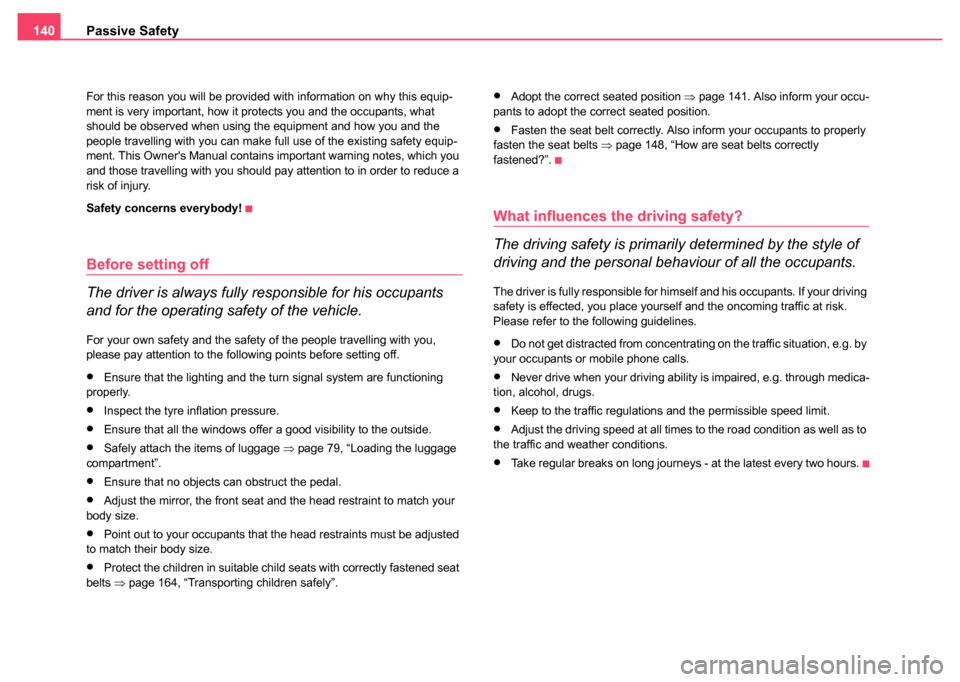
Passive Safety
140
For this reason you will be provided with information on why this equip-
ment is very important, how it protects you and the occupants, what
should be observed when using the equipment and how you and the
people travelling with you can make full use of the existing safety equip-
ment. This Owner's Manual contains important warning notes, which you
and those travelling with you should pay attention to in order to reduce a
risk of injury.
Safety concerns everybody!
Before setting off
The driver is always fully responsible for his occupants
and for the operating safety of the vehicle.
For your own safety and the safety of the people travelling with you,
please pay attention to the following points before setting off.
•Ensure that the lighting and the turn signal system are functioning
properly.
•Inspect the tyre inflation pressure.
•Ensure that all the windows offer a good visibility to the outside.
•Safely attach the items of luggage ⇒page 79, “Loading the luggage
compartment”.
•Ensure that no objects can obstruct the pedal.
•Adjust the mirror, the front seat and the head restraint to match your
body size.
•Point out to your occupants that the head restraints must be adjusted
to match their body size.
•Protect the children in suitable child seats with correctly fastened seat
belts ⇒page 164, “Transporting children safely”.
•Adopt the correct seated position ⇒page 141. Also inform your occu-
pants to adopt the correct seated position.
•Fasten the seat belt correctly. Also inform your occupants to properly
fasten the seat belts ⇒page 148, “How are seat belts correctly
fastened?”.
What influences the driving safety?
The driving safety is primarily determined by the style of
driving and the personal behaviour of all the occupants.
The driver is fully responsible for himself and his occupants. If your driving
safety is effected, you place yourself and the oncoming traffic at risk.
Please refer to the following guidelines.
•Do not get distracted from concentrating on the traffic situation, e.g. by
your occupants or mobile phone calls.
•Never drive when your driving ability is impaired, e.g. through medica-
tion, alcohol, drugs.
•Keep to the traffic regulations and the permissible speed limit.
•Adjust the driving speed at all times to the road condition as well as to
the traffic and weather conditions.
•Take regular breaks on long journeys - at the latest every two hours.
Page 142 of 270

Passive Safety141
Using the systemSafetyDriving TipsGeneral MaintenanceBreakdown assistanceTechnical Data
Correct seated position
Correct seated position for the driver
Correct seated position for the driver is important for safe
and relaxed driving.
For your own safety and to reduce the risk of injury in the event of an acci-
dent, we recommend the following setting.
•Adjust the steering wheel so that the distance between the steering
wheel and your chest is at least 25 cm ⇒fig. 122 .
•Position the driver seat in the forward/back direction so that you are
able to press the pedals with your legs at a slight angle .
•Adjust the backrest so that you are able to reach the highest point of
the steering wheel with your arms at a slight angle.
•Adjust the head restraint so that the top edge of the head restraint is
at the same level as the upper part of your head ⇒fig. 123 .
•Fasten the seat belt correctly ⇒page 148, “How are seat belts
correctly fastened?”.
Manually adjust the driver seat ⇒page 70, “Adjusting front seats manu-
ally”.
Electrically adjust the driver seat ⇒page 71, “Adjusting seats”.
Fig. 122 The correct
distance of the driver
from the steering wheel
Fig. 123 The correct
head restraint adjust-
ment for the driver
Page 153 of 270

Airbag system
152
Airbag system
Description of the airbag system
General information on the airbag system
The front airbag system is complementary to the three-point seat belts
and offers additional protection for the head and chest area of the driver
and passenger in the event of a frontal collision.
In the case of a violent side crash, the side and head airbags* reduce the
risk of injuries to the occupants on the part of the body facing the side of
the accident ⇒.
The airbag system is only functional after the ignition has been switched
on.
The operational readiness of the airbag system is monitored electroni-
cally. The airbag warning light comes on for a few seconds each time the
ignition is switched on.
The airbag system (according to vehicle equipment) essentially
consists of:
•an electronic control unit
•the two front airbags
•the side airbags
•head airbags*
•an airbag warning light in the instrument cluster
•a front passenger airbag switch* ⇒page 162
•an indicator light showing a switched-off front passenger airbag* in the
middle of the dash panel ⇒page 162 A fault in the airbag system exists if:
•the airbag indicator light does not light up when the ignition is switched
on
•the warning light does not go out after about 3 seconds after the igni-
tion is switched on
•the airbag indicator light goes out and comes on again after the ignition
is switched on
•the airbag indicator light comes on or flickers when driving
•an airbag indicator light showing a switched-off front passenger
airbag* in the middle of the dash panel flashes
WARNING
•To enable the occupants of a car to be protected with the
greatest possible effect when the airbag is deployed, the front
seats must be ⇒page 141, “Correct seated position” correctly
adjusted to match the body size of the occupant.
•If you do not fasten the seat belts when driving, lean too far
forward or adopt an incorrect seated position, you are exposing
yourself to increased risk of injury in the event of an accident.
•Have the airbag system checked immediately by a Škoda dealer
if a fault exists. Otherwise, there is a risk of the airbag not being
activated in the event of an accident.
•No modifications of any kind may be made to parts of the airbag
system.
•It is prohibited to manipulate individual parts of the airbag
system as this might result in the airbag being deployed.
Page 154 of 270
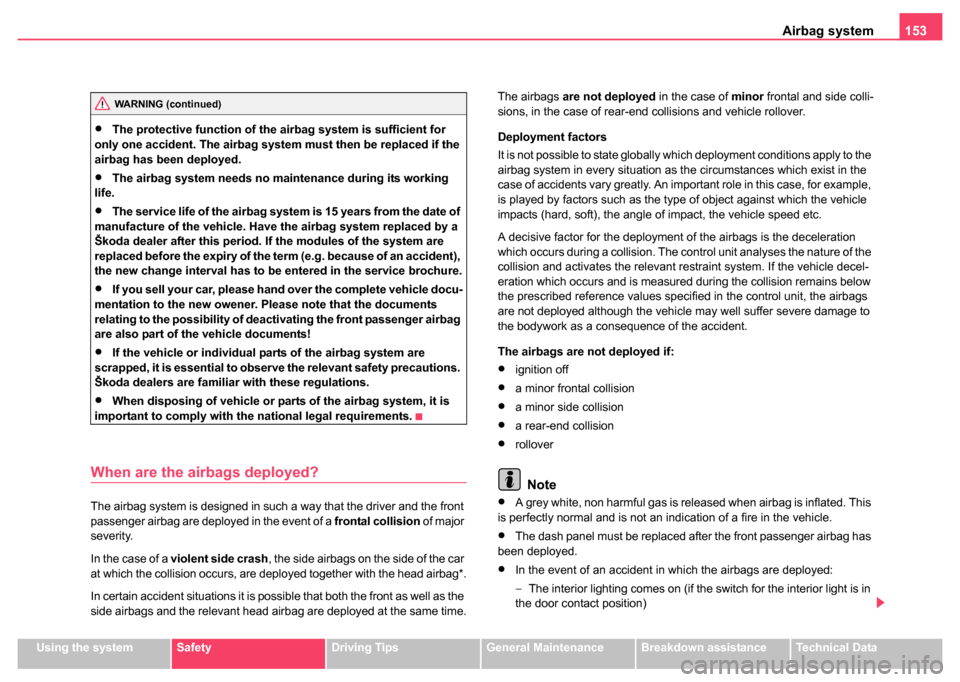
Airbag system153
Using the systemSafetyDriving TipsGeneral MaintenanceBreakdown assistanceTechnical Data
•The protective function of the airbag system is sufficient for
only one accident. The airbag system must then be replaced if the
airbag has been deployed.
•The airbag system needs no maintenance during its working
life.
•The service life of the airbag system is 15 years from the date of
manufacture of the vehicle. Have the airbag system replaced by a
Škoda dealer after this period. If the modules of the system are
replaced before the expiry of the term (e.g. because of an accident),
the new change interval has to be entered in the service brochure.
•If you sell your car, please hand over the complete vehicle docu-
mentation to the new owener. Please note that the documents
relating to the possibility of deactivating the front passenger airbag
are also part of the vehicle documents!
•If the vehicle or individual parts of the airbag system are
scrapped, it is essential to observe the relevant safety precautions.
Škoda dealers are familiar with these regulations.
•When disposing of vehicle or parts of the airbag system, it is
important to comply with th e national legal requirements.
When are the airbags deployed?
The airbag system is designed in such a way that the driver and the front
passenger airbag are deployed in the event of a frontal collision of major
severity.
In the case of a violent side crash , the side airbags on the side of the car
at which the collision occurs, are deployed together with the head airbag*.
In certain accident situations it is possible that both the front as well as the
side airbags and the relevant head airbag are deployed at the same time. The airbags
are not deployed in the case of minor frontal and side colli-
sions, in the case of rear-end collisions and vehicle rollover.
Deployment factors
It is not possible to state globally which deployment conditions apply to the
airbag system in every situation as the circumstances which exist in the
case of accidents vary greatly. An important role in this case, for example,
is played by factors such as the type of object against which the vehicle
impacts (hard, soft), the angle of impact, the vehicle speed etc.
A decisive factor for the deployment of the airbags is the deceleration
which occurs during a collision. The control unit analyses the nature of the
collision and activates the relevant restraint system. If the vehicle decel-
eration which occurs and is measured during the collision remains below
the prescribed reference values specified in the control unit, the airbags
are not deployed although the vehicle may well suffer severe damage to
the bodywork as a consequence of the accident.
The airbags are not deployed if:
•ignition off
•a minor frontal collision
•a minor side collision
•a rear-end collision
•rollover
Note
•A grey white, non harmful gas is released when airbag is inflated. This
is perfectly normal and is not an indication of a fire in the vehicle.
•The dash panel must be replaced after the front passenger airbag has
been deployed.
•In the event of an accident in which the airbags are deployed:
− The interior lighting comes on (if the switch for the interior light is in
the door contact position)
WARNING (continued)
Page 155 of 270
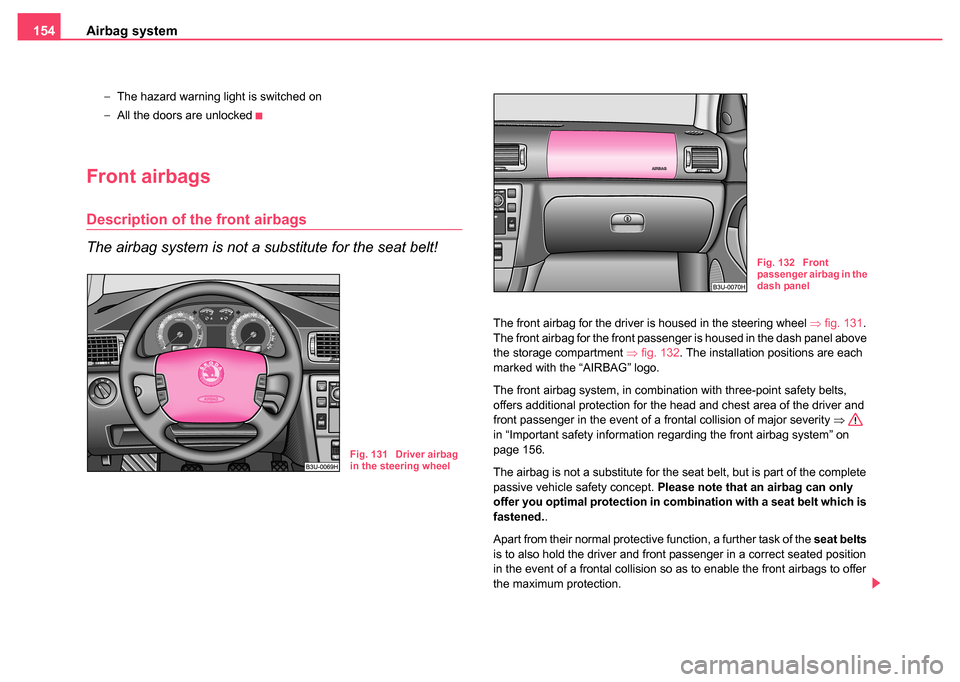
Airbag system
154
− The hazard warning light is switched on
− All the doors are unlocked
Front airbags
Description of the front airbags
The airbag system is not a substitute for the seat belt!
The front airbag for the driver is housed in the steering wheel ⇒fig. 131 .
The front airbag for the front passenger is housed in the dash panel above
the storage compartment ⇒fig. 132 . The installation positions are each
marked with the “AIRBAG” logo.
The front airbag system, in combination with three-point safety belts,
offers additional protection for the head and chest area of the driver and
front passenger in the event of a frontal collision of major severity ⇒
in “Important safety information regarding the front airbag system” on
page 156.
The airbag is not a substitute for the seat belt, but is part of the complete
passive vehicle safety concept. Please note that an airbag can only
offer you optimal protection in combination with a seat belt which is
fastened. .
Apart from their normal protective function, a further task of the seat belts
is to also hold the driver and front passenger in a correct seated position
in the event of a frontal collision so as to enable the front airbags to offer
the maximum protection.
Fig. 131 Driver airbag
in the steering wheel
Fig. 132 Front
passenger airbag in the
dash panel
Page 159 of 270
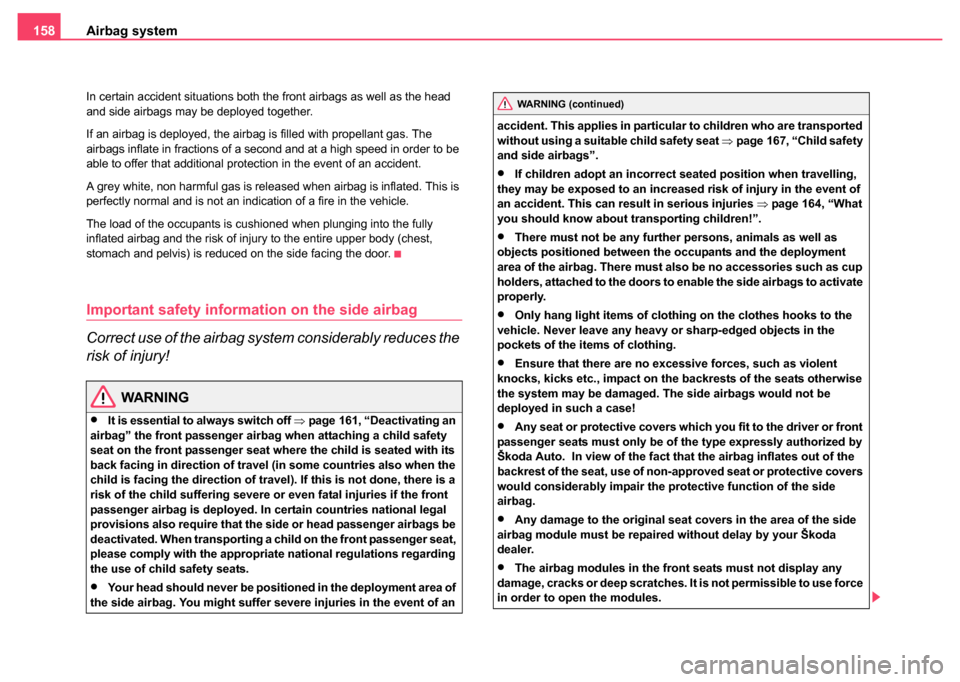
Airbag system
158
In certain accident situations both the front airbags as well as the head
and side airbags may be deployed together.
If an airbag is deployed, the airbag is filled with propellant gas. The
airbags inflate in fractions of a second and at a high speed in order to be
able to offer that additional protection in the event of an accident.
A grey white, non harmful gas is released when airbag is inflated. This is
perfectly normal and is not an indication of a fire in the vehicle.
The load of the occupants is cushioned when plunging into the fully
inflated airbag and the risk of injury to the entire upper body (chest,
stomach and pelvis) is reduced on the side facing the door.
Important safety information on the side airbag
Correct use of the airbag system considerably reduces the
risk of injury!
WARNING
•It is essential to always switch off ⇒page 161, “Deactivating an
airbag” the front passenger airbag when attaching a child safety
seat on the front passenger seat where the child is seated with its
back facing in direction of travel (in some countries also when the
child is facing the direction of travel). If this is not done, there is a
risk of the child suffering severe or even fatal injuries if the front
passenger airbag is deployed. In certain countries national legal
provisions also require that the side or head passenger airbags be
deactivated. When transporting a child on the front passenger seat,
please comply with the appropriate national regulations regarding
the use of child safety seats.
•Your head should never be positioned in the deployment area of
the side airbag. You might suffer severe injuries in the event of an accident. This applies in particular to children who are transported
without using a suitable child safety seat
⇒page 167, “Child safety
and side airbags”.
•If children adopt an incorrect seated position when travelling,
they may be exposed to an increased risk of injury in the event of
an accident. This can result in serious injuries ⇒page 164, “What
you should know about transporting children!”.
•There must not be any further persons, animals as well as
objects positioned between the occupants and the deployment
area of the airbag. There must also be no accessories such as cup
holders, attached to the doors to enable the side airbags to activate
properly.
•Only hang light items of clothing on the clothes hooks to the
vehicle. Never leave any heavy or sharp-edged objects in the
pockets of the items of clothing.
•Ensure that there are no excessive forces, such as violent
knocks, kicks etc., impact on the backrests of the seats otherwise
the system may be damaged. The side airbags would not be
deployed in such a case!
•Any seat or protective covers which you fit to the driver or front
passenger seats must only be of the type expressly authorized by
Škoda Auto. In view of the fact that the airbag inflates out of the
backrest of the seat, use of non-approved seat or protective covers
would considerably impair the protective function of the side
airbag.
•Any damage to the original seat covers in the area of the side
airbag module must be repaired without delay by your Škoda
dealer.
•The airbag modules in the front seats must not display any
damage, cracks or deep scratches. It is not permissible to use force
in order to open the modules.
WARNING (continued)
Page 161 of 270
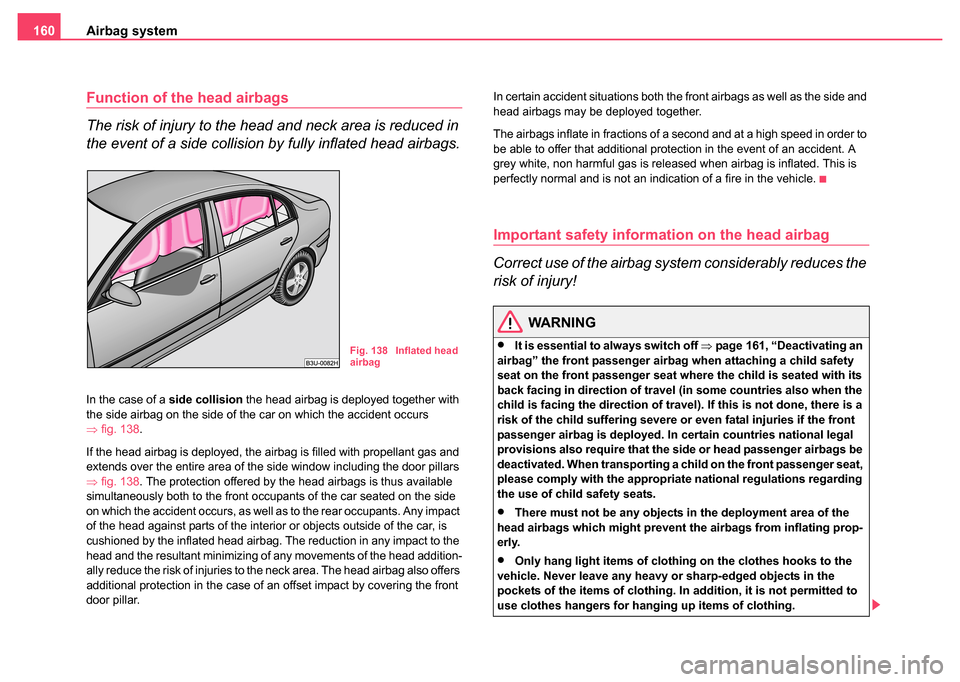
Airbag system
160
Function of the head airbags
The risk of injury to the head and neck area is reduced in
the event of a side collision by fully inflated head airbags.
In the case of a side collision the head airbag is deployed together with
the side airbag on the side of the car on which the accident occurs
⇒ fig. 138 .
If the head airbag is deployed, the airbag is filled with propellant gas and
extends over the entire area of the side window including the door pillars
⇒ fig. 138 . The protection offered by the head airbags is thus available
simultaneously both to the front occupants of the car seated on the side
on which the accident occurs, as well as to the rear occupants. Any impact
of the head against parts of the interior or objects outside of the car, is
cushioned by the inflated head airbag. The reduction in any impact to the
head and the resultant minimizing of any movements of the head addition-
ally reduce the risk of injuries to the neck area. The head airbag also offers
additional protection in the case of an offset impact by covering the front
door pillar. In certain accident situations both the front airbags as well as the side and
head airbags may be deployed together.
The airbags inflate in fractions of a second and at a high speed in order to
be able to offer that additional protection in the event of an accident. A
grey white, non harmful gas is released when airbag is inflated. This is
perfectly normal and is not an indication of a fire in the vehicle.
Important safety informati
on on the head airbag
Correct use of the airbag system considerably reduces the
risk of injury!
WARNING
•It is essential to always switch off ⇒ page 161, “Deactivating an
airbag” the front passenger airbag when attaching a child safety
seat on the front passenger seat where the child is seated with its
back facing in direction of travel (in some countries also when the
child is facing the direction of travel). If this is not done, there is a
risk of the child suffering severe or even fatal injuries if the front
passenger airbag is deployed. In certain countries national legal
provisions also require that the side or head passenger airbags be
deactivated. When transporting a child on the front passenger seat,
please comply with the appropriat e national regulations regarding
the use of child safety seats.
•There must not be any objects in the deployment area of the
head airbags which might prevent the airbags from inflating prop-
erly.
•Only hang light items of clothing on the clothes hooks to the
vehicle. Never leave any heavy or sharp-edged objects in the
pockets of the items of clothing. In addition, it is not permitted to
use clothes hangers for hanging up items of clothing.
Fig. 138 Inflated head
airbag
Page 163 of 270

Airbag system
162
Monitoring the airbag system
The functionality of the airbag system is also monitored electronically,
when one airbag has been switched off
An airbag which has been switched off by a Škoda dealer using the
vehicle system tester:
•The warning light for the airbag system lights up for 3 seconds after
switching on the ignition and then flashes for 12 seconds afterwards in 2
second intervals.
Front passenger airbags switched off using the switch for front
passenger airbags* in stowage compartment on the front passenger
side:
•The airbag indicator light in the instrument cluster comes on for about
3 seconds each time the ignition is switched on.
•Switching off airbags is indicated in the middle of the dash panel by the
lighting up of the indicator light ⇒ page 162.
Note
Your Škoda dealer will be able to advise you whether national legislation
in your country allows airbags in your vehicle to be deactivated, and which
ones.
Switch for th e front seat passenger airbags*
The front and side passenger airbag is deactivated with the
switch.
Fig. 139 Storage
compartment: Switch
for the front seat
passenger airbags
Fig. 140 Indicator light
for a switched off front
seat passenger airbag
Page 164 of 270

Airbag system163
Using the systemSafetyDriving TipsGeneral MaintenanceBreakdown assistanceTechnical Data
Deactivating airbags
– Switch off the ignition.
– Turn the slot of the airbag switch using the master key in the
direction of the arrow to the position OFF ⇒ fig. 139. The slot
of the airbag switch must be located in the vertical position.
– Check whether the airbag indicator light
in the
middle of the dash panel lights up ⇒fig. 140 when the ignition
is turned on.
Switching on airbags
– Switch off the ignition.
– Turn the slot of the airbag switch using the master key in the direction of the arrow to the position ON ⇒ page 162, fig. 139.
The slot of the airbag switch must be located in the horizontal
position.
– Check whether the airbag indicator light
in the
middle of the dash panel lights up ⇒page 162, fig. 140 when
the ignition is turned on.
The airbags should only be switched off under exceptional circumstances
⇒ page 161.
Indicator light
(airbag switched off)
The airbag indicator light is located in the middle of the dash panel
⇒ page 162, fig. 140 .
If the airbags are switched on , the airbag indicator light comes on for a
few seconds after the ignition is switched on.
When the front and side passenger airbag is switched off, the indicator
light comes on after the ignition is switched on. There is a system fault present in the airbag switch off
⇒ if the indi-
cator light flashes. Please have the vehicle inspected without delay by
a Škoda dealer.
WARNING
•Only switch off the airbags when the ignition is switched off!
Otherwise a fault can arise on the airbag system and therefore
could cause the airbag to trigger.
•The driver is responsible for whether the airbags are switched
on or switched off.
•If the indicator light flashes:
− There is a risk of the front passenger airbag or the side
passenger airbag not being deployed in the event of an acci-
dent.
− There is the risk, if someone is sitting on the front passenger
seat, that the front passenger will suffer injury if the airbag is
suddenly deployed.